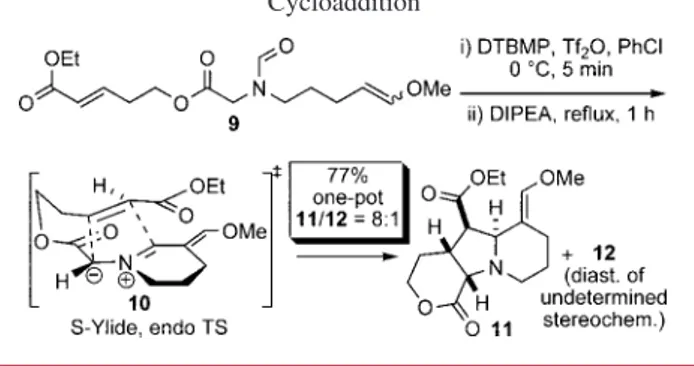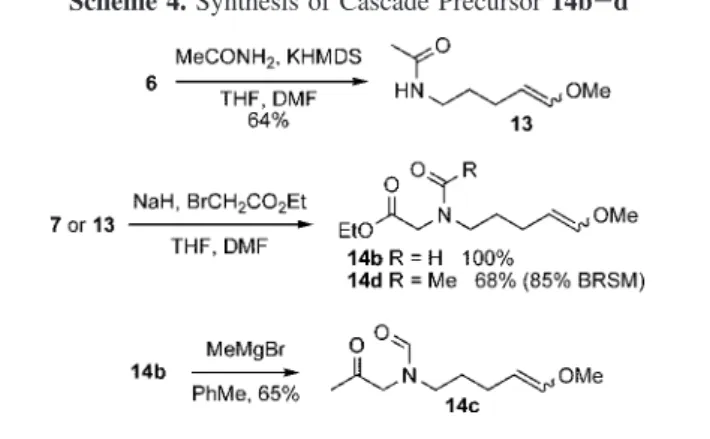A Versatile Cascade of Intramolecular
Vilsmeier-Haack and Azomethine Ylide
1,3-Dipolar Cycloaddition toward
Tricyclic Cores of Alkaloids
†
Franc¸ois Le´vesque and Guillaume Be´langer*
De´partement de Chimie, UniVersite´ de Sherbrooke, 2500 bouleVard UniVersite´, Sherbrooke, Que´bec J1K 2R1, Canada
guillaume.belanger@usherbrooke.ca Received August 27, 2008
ABSTRACT
In the pursuit of synthetic efficiency, we developed an innovative one-pot transformation of linear substrates into bi- and tricyclic adducts using a cascade of amide activation, nucleophilic cyclization, azomethine ylide generation, and subsequent inter- or intramolecular 1,3-dipolar cycloaddition. Despite the high density and variety of functional groups on the substrates, the sequence occurred with perfect chemoselectivity with good to excellent yields.
The pursuit of synthetic efficiency has been driving synthetic chemists over the years. The rapid and controlled increase in molecular complexity constitutes an enormous challenge for the construction of polycyclic natural products. Reactions in cascade certainly offer a powerful means to reach this goal, as several bonds can be formed in a single operation.1 With this in mind, we became interested in exploring a new cascade of reactions that combines our recently developed Vilsmeier-Haack cyclization methodology2with the genera-tion of an azomethine ylide and a subsequent intramolecular 1,3-dipolar cycloaddition (Scheme 1).3
The versatility of our planned synthetic strategy is noteworthy. The branches bearing the nucleophile and the †Dedicated to Professor Pierre Deslongchamps on the occasion of his
70th birthday.
(1) (a) Tietze, L. F.; Brasche, G.; Gericke, K. M. Domino Reactions in Organic Chemistry; WILEY-VCH: Weinheim, 2006; p 672. (b) Nicolaou, K. C.; Edmonds, D. J.; Bulger, P. G. Angew. Chem., Int. Ed. 2006, 45, 7134.
(2) (a) Be´langer, G.; Larouche-Gauthier, R.; Me´nard, F.; Nantel, M.; Barabe´, F. Org. Lett. 2005, 7, 4431. (b) Be´langer, G.; Larouche-Gauthier, R.; Me´nard, F.; Nantel, M.; Barabe´, F. J. Org. Chem. 2006, 71, 704.
(3) For reviews on azomethine ylides, see: (a) Coldham, I.; Hufton, R. Chem. ReV. 2005, 105, 2765. (b) Tsuge, O.; Kanemasa, S. AdV. Heterocycl. Chem. 1989, 45, 231.
Scheme 1.Planned Synthetic Strategy
ORGANIC
LETTERS
2008
Vol. 10, No. 21
4939-4942
10.1021/ol802010n CCC: $40.75 2008 American Chemical Society
dipolarophile can be attached anywhere about the amide. Upon the proposed key transformation, the various possible assemblies for a starting material substrate will lead to very diverse skeletons that belong to a wide range of alkaloid families of pharmaceutical interest.
We already demonstrated that iminium ions (cf. 2), generated from intramolecular Vilsmeier-Haack reactions, are stable and could sometimes be isolated.2Addition of a suitable tethered dipolarophile should trap the ylide 3, itself formed through a deprotonation of 2, and generate the second and third cycles of the desired cascade product 4. Such structures are found in numerous steroidal alkaloids, such as leptinidine,4daphnane alkaloids, and others. The greatest challenge in the development of this reaction sequence is certainly the numerous chemoselectivity issues associated with each step of the desired cascade since the reactivity and the order of reaction of the four required functional groups must be perfectly controlled.
In order to prove the viability of our planned synthetic strategy, we prepared and then tested a first model compound bearing a methyl enol ether as the nucleophile for the Vilsmeier-Haack cyclization and a tethered dipolarophile for the final 1,3-dipolar cycloaddition. Preparation of precur-sor 9 started with iodination of known alcohol 55(Scheme 2). Iodide 6 then served in the alkylation of formamide to
generate 7. The latter was alkylated again, this time with known bromoester 8.6
The possibility of generating three cycles in a single sequence was then examined. When the highly function-alized model substrate 9 was treated with triflic anhydride in the presence of 2,6-di-tert-butyl-4-methylpyridine (DT-BMP), the resulting triflyliminium ion reacted exclusively with the electron-rich alkene in a Vilsmeier-Haack-type cyclization (Scheme 3). Upon deprotonation, the azome-thine ylide 10 was generated and then reacted with the remaining electron-poor alkene in a highly diastereose-lective intramolecular 1,3-dipolar cycloaddition.
The success of the reaction hinged on ylide generation at a temperature that could then promote the dipolar cycloaddition. Lower temperatures resulted in complete decomposition of the reactive ylide.7The whole cascade of reactions occurred with perfect chemoselectivity. An 8:1 mixture of 11/12 was obtained in 77% overall yield, which is excellent for this one-pot tricyclization from linear 9.8The relative stereochemistry of all four adjacent stereocenters in 11 was confirmed by
single-crystal X-ray analysis (Figure 1) and is the result of an endo transition state for the cycloaddition of the ylide 10 in an S conformation; endo/exo transition state preferences and ylide conformation are discussed in detailed below.
With this especially encouraging result, we established the feasibility of the rapid increase in molecular complexity in one operation using our synthetic strategy. For the following identification of the scope and limitations of the strategy, we opted for the study of easily accessible model compounds in a Vilsmeier-Haack cyclization-intermolecular cycload-dition sequence.
Preparation of precursors 14b-d is detailed in Scheme 4.9 Acetamide was alkylated with iodide 6 to give compound 13. Alkylation of the anion of either the formamide 7 or the acetamide 13 with ethyl bromoacetate furnished the precursors 14b and 14d, respectively. A methyl Grignard addition to 14b at low temperature produced the methylketone 14c.
Since the first part of the cascade, the Vilsmeier-Haack type cyclization, has already been successfully developed,2 we concentrated our efforts on the azomethine ylide genera-tion and the subsequent 1,3-dipolar cycloaddigenera-tion. Therefore, a series of bases was screened for the azomethine ylide generation (tested with substrate 14b). Although many bases were either unreactive10aor caused the decomposition of the substrate,10bwe found that DIPEA had the best balance of Scheme 2.Synthesis of Cascade Precursor 9
Scheme 3.Cascade of Intramolecular
Vilsmeier-Haack-Azomethine Ylide Generation-1,3-Dipolar Cycloaddition
Figure 1. ORTEP representation of the single-crystal X-ray structure of 11.
high basicity and low nucleophilicity.10c We also rapidly concluded that the azomethine ylide was unstable and needed to react immediately with a dipolarophile upon its genera-tion.11 To this end, N-phenylmaleimide was chosen as a prototypic highly reactive dipolarophile.
In order to study the scope of the reaction cascade, the optimized conditions were used with model compounds
14a-e (Table 1). Both the silyl (14a) and methyl (14b) enol
ethers led to the desired cycloadducts (entries 1 and 2, respectively), although 14b gave a much better yield (92%), presumably because of the lower acid12 sensitivity of the methyl enol ether. Delightfully, excellent yields (82-92%) were obtained with either the ester (14b, entry 2) or the ketone (14c, entry 3).2,13
Finally, in order to verify the capacity of the reaction cascade to withstand steric hindrance, we replaced the formamide (14b, entry 2) with bulkier groups. In the case
of the acetamide (14d, entry 4), no cycloadduct was observed, even though the iminium ion intermediate was completely formed.14We suspect that deprotonation leading to the resulting enamine was preferred to the generation of the ylide.15 This competing deprotonation pathway was circumvented by replacing the methyl with a phenyl (14e, entry 5). We were pleased to see that generation of a quaternary center was thus possible at this position (16e/
17e, 63% combined yield), even though a higher
cycload-dition temperature was required.
The relative stereochemistry of all cycloadducts was examined. The relationship between C2 and C5 in the
cycloadducts 15 and 16 could be rationalized on the basis of the geometry of the ylide (Scheme 5).
When the substituent R3 on the amide was an hydrogen
(entries 1-3), electrostatic stabilization in the S conformation prevails,16 leading preferentially to 15a-c. Closely related
examples showed that such substrates give endo and exo adducts resulting from a common S-ylide intermediate.17 However, 14a-c furnished only endo adducts 15a-c and
16a-c, regardless of the ylide geometry. In the case where
the amide substituent R3 was a phenyl (entry 5), steric
hindrance destabilized the S conformation, and the cycload-ducts 16e and 17e obtained both stem from a W-ylide, via endo and exo cycloaddition transtition states, respectively. Structures of 16e and 17e were proven by single crystal X-Ray diffraction.
Note that in all of the cycloadducts, the enol ether had a trans geometry, as a result of the initial Vilsmeier-Haack reaction. For instance, after amide 18 is activated, the nucleophilic addition of the tethered enol ether gerenates a Scheme 4.Synthesis of Cascade Precursor 14b-d
Table 1. Scope of the Key Reaction Cascadea
aReagent and conditions: (i) DTBMP, Tf
2O, CH2Cl2, 0°C, 5 min; (ii) N-phenylmaleimide; (iii) DIPEA, 15 min. (b) Ratio determined by NMR analysis
of crude material. (c) Combined yield of diastereoisomers. (d) Step (iii) conducted in refluxing toluene.
carboxonium ion 19 (Scheme 6). The latter gets deprotonated to give the less sterically congested trans enol ether 20, leading to unsaturated iminium ion 21 upon triflate expulsion. In conclusion, we demonstrated that a new synthetic strategy that exploits our recently developed Vilsmeier-Haack cyclization coupled to the generation and cycloaddition of its azomethine ylide is a powerful, rapid, and efficient
approach to polycyclic alkaloid cores. The generation of bicyclic and tricyclic adducts occurred in a single operation from an acyclic substrate with perfect chemoselectivity. Diastereoselectivity of the process is fully rationalized. Applications of our strategy to the total synthesis of alkaloids are now in progress.
Acknowledgment. This research was supported by the
Natural Science and Engineering Research Council (NSERC) of Canada, FQRNT (Que´bec), the Canadian Fund for Innovation (CFI), and the Universite´ de Sherbrooke. The Universite´ de Sherbrooke is acknowledged for Ph. D. fellowship to F.L.
Supporting Information Available: Experimental details
and spectra for all new compounds, including CIF files. This material is available free of charge via the Internet at http://pubs.acs.org.
OL802010N
(4) Coelho, R. M.; De Souza, M. C.; Sarragiotto, M. H. Phytochemistry
1998, 49, 893.
(5) Methyl enol ether 5 is obtained from a Wittig olefination of γ-butyrolactol. See: Wasserman, H. H.; Cook, J. D.; Vu, C. B. J. Org. Chem.
1990, 55, 1701.
(6) Jones, R. C. F.; Howard, K. J.; Nichols, J. R.; Snaith, J. S. J. Chem. Soc., Perkin Trans. 1 1998, 13, 2061.
(7) The electron withdrawing group (CO2Et) on the dipolarophile was
found to be necessary for the success of the cycloaddition. The unsubstituted terminal alkene proved to not be reactive enough, in accordance with the major HOMOazomethine ylide-LUMOdipolarophileinteraction in such 1,3-dipolar
cycloadditions. See: Houk, K. N.; Sims, J.; Watts, C. R.; Luskus, L. J. J. Am. Chem. Soc. 1968, 90, 543.
(8) The increased thermal stability of methyl enol ether over silyl enol ether was dramatic: for substrate 9, when the methyl group is substituted for a TBDMS, only 29% overall yield of tricyclic adduct was obtained.
(9) Preparation of models 14a and 14e is described in Supporting Information.
(10) (a) DTBMP, DABCO, Cs2CO3. (b) KHMDS, LTMP, and NaH.
(c) Nucleophilic bases (such as DBU) initiated undesired anionic polym-erization of N-phenylmaleimide presumably via Michael addition of the base onto N-phenylmaleimide.
(11) Any attempts to form the azomethine ylide prior to the addition of the dipolarophile led to low yield of cycloadduct.
(12) Compounds 15a/16a decomposed slowly upon purification on silica gel.
(13) For another example of chemoselective amide activation in the presence of a ketone, see: Barbe, G.; Charette, A. B. J. Am. Chem. Soc.
2008, 130, 18.
(14) Confirmed by1H NMR spectroscopy (see Supporting
Informa-tion).
(15) Even though the resulting enamine was not observed, its formation has been proven in several occasions. For example, see: Smith, R.; Livinghouse, T. Tetrahedron 1985, 41, 3559.
(16) Tsuge, O.; Kanemasa, S.; Takenaka, S. Chem. Lett. 1985, 355. (17) To´th, G.; Frank, J.; Bende, Z.; Weber, L.; Simon, K. J. Chem. Soc., Perkin Trans. 1 1985, 1961.
Scheme 5.Geometry of the Azomethine Ylide and endo/exo Transition States
Scheme 6.Geometry of Enol Ether in Cycloadducts

